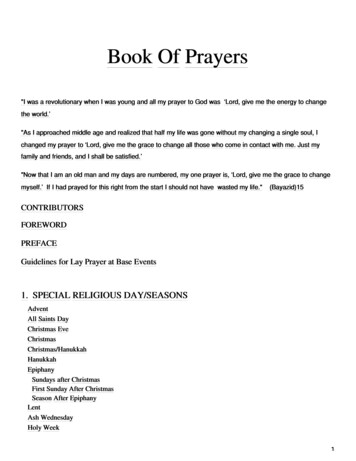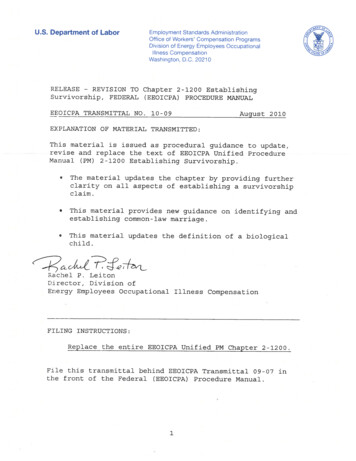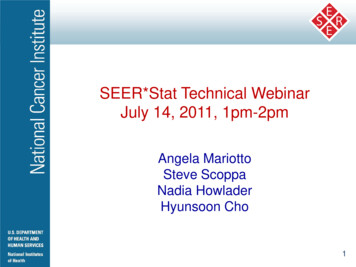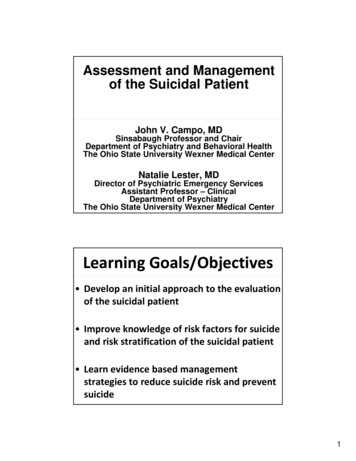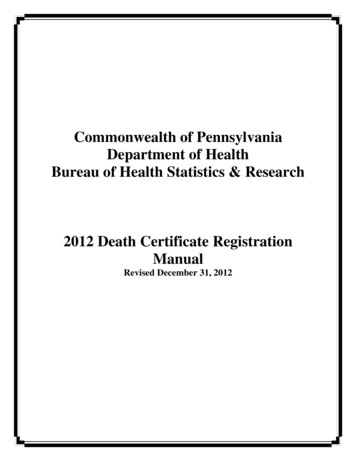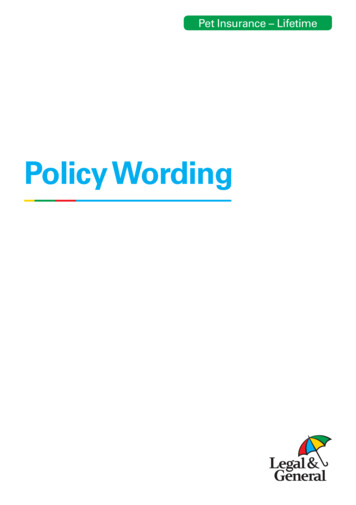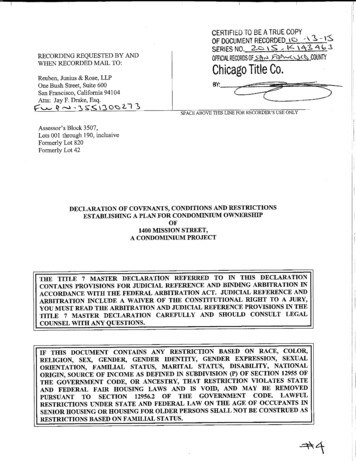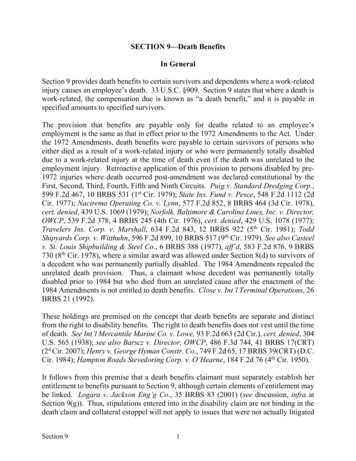
Transcription
SECTION 9—Death BenefitsIn GeneralSection 9 provides death benefits to certain survivors and dependents where a work-relatedinjury causes an employee’s death. 33 U.S.C. §909. Section 9 states that where a death iswork-related, the compensation due is known as “a death benefit,” and it is payable inspecified amounts to specified survivors.The provision that benefits are payable only for deaths related to an employee’semployment is the same as that in effect prior to the 1972 Amendments to the Act. Underthe 1972 Amendments, death benefits were payable to certain survivors of persons whoeither died as a result of a work-related injury or who were permanently totally disableddue to a work-related injury at the time of death even if the death was unrelated to theemployment injury. Retroactive application of this provision to persons disabled by pre1972 injuries where death occurred post-amendment was declared constitutional by theFirst, Second, Third, Fourth, Fifth and Ninth Circuits. Puig v. Standard Dredging Corp.,599 F.2d 467, 10 BRBS 531 (1st Cir. 1979); State Ins. Fund v. Pesce, 548 F.2d 1112 (2dCir. 1977); Nacirema Operating Co. v. Lynn, 577 F.2d 852, 8 BRBS 464 (3d Cir. 1978),cert. denied, 439 U.S. 1069 (1979); Norfolk, Baltimore & Carolina Lines, Inc. v. Director,OWCP, 539 F.2d 378, 4 BRBS 245 (4th Cir. 1976), cert. denied, 429 U.S. 1078 (1977);Travelers Ins. Corp. v. Marshall, 634 F.2d 843, 12 BRBS 922 (5th Cir. 1981); ToddShipyards Corp. v. Witthuhn, 596 F.2d 899, 10 BRBS 517 (9th Cir. 1979). See also Casteelv. St. Louis Shipbuilding & Steel Co., 6 BRBS 388 (1977), aff’d, 583 F.2d 876, 9 BRBS730 (8th Cir. 1978), where a similar award was allowed under Section 8(d) to survivors ofa decedent who was permanently partially disabled. The 1984 Amendments repealed theunrelated death provision. Thus, a claimant whose decedent was permanently totallydisabled prior to 1984 but who died from an unrelated cause after the enactment of the1984 Amendments is not entitled to death benefits. Close v. Int’l Terminal Operations, 26BRBS 21 (1992).These holdings are premised on the concept that death benefits are separate and distinctfrom the right to disability benefits. The right to death benefits does not vest until the timeof death. See Int’l Mercantile Marine Co. v. Lowe, 93 F.2d 663 (2d Cir.), cert. denied, 304U.S. 565 (1938); see also Barscz v. Director, OWCP, 486 F.3d 744, 41 BRBS 17(CRT)(2d Cir. 2007); Henry v. George Hyman Constr. Co., 749 F.2d 65, 17 BRBS 39(CRT) (D.C.Cir. 1984); Hampton Roads Stevedoring Corp. v. O’Hearne, 184 F.2d 76 (4th Cir. 1950).It follows from this premise that a death benefits claimant must separately establish herentitlement to benefits pursuant to Section 9, although certain elements of entitlement maybe linked. Logara v. Jackson Eng’g Co., 35 BRBS 83 (2001) (see discussion, infra atSection 9(g)). Thus, stipulations entered into in the disability claim are not binding in thedeath claim and collateral estoppel will not apply to issues that were not actually litigatedSection 91
in the prior claim. Uzdavines v. Weeks Marine, Inc., 37 BRBS 45 (2003), aff’d, 418 F3d138, 39 BRBS 47(CRT) (2d Cir. 2005).The carrier at risk at the time of decedent’s injury, not at the time of death, is responsiblefor payment of death benefits. Spence v. Terminal Shipping Co., 7 BRBS 128 (1977), aff’dsub nom. Pennsylvania Nat’l Mut. Cas. Ins. Co. v. Spence, 591 F.2d 985, 9 BRBS 714 (4thCir. 1979), cert. denied, 444 U.S. 963 (1975); Marshall v. Looney’s Sheet Metal Shop, 10BRBS 728 (1978), aff’d sub nom. Travelers Ins. Co. v. Marshall, 634 F.2d 843, 12 BRBS922 (5th Cir. 1981).Section 20(a) presumes, in the absence of substantial evidence to the contrary, that theclaim for death benefits comes within the provisions of the Act, i.e., that the death wasemployment-related. Sprague v. Director, OWCP, 688 F.2d 862, 15 BRBS 11(CRT) (1stCir. 1982). In Woodside v. Bethlehem Steel Corp., 14 BRBS 601 (1982) (Ramsey,dissenting), a majority of the Board held that the administrative law judge erred in notapplying the Section 20(a) presumption where claimant suffered from chronic obstructivepulmonary disease (COPD) potentially related to his employment and alleged that thiscondition hastened his death due to renal cancer. The Board remanded for theadministrative law judge to apply the presumption to the COPD, determine whether it wasrelated to his employment and then determine whether the death was work-related underthe maxim that “to hasten death is to cause it.” Id., 14 BRBS at 603. See also 33 U.S.C.§§902(2), 920(a).An award for scheduled permanent partial disability benefits may be made following anemployee’s death under Section 8(d). Such an award is not a claim for death benefits andcan be received concurrently with Section 9 death benefits. Henry v. George HymanConstr. Co., 749 F.2d 65, 17 BRBS 39(CRT) (D.C. Cir. 1984), rev’g 15 BRBS 475 (1983).A separate claim for death benefits must be filed in order to receive benefits under Section9. Almeida v. Gen. Dynamics Corp., 12 BRBS 901 (1980). The Section 9 claim mustcomply with Section 13 and thus must be filed within the specified time period fortraumatic injury or occupational diseases after the claimant is aware or should have beenaware of the relationship between the death and employment, or within one year of the lastpayment of death benefits. 33 U.S.C. §913(a), (b)(2); Stark v. Bethlehem Steel Corp., 6BRBS 600 (1977). See Wilson v. Vecco Concrete Constr. Co., 16 BRBS 22 (1983); Section13 of the desk book. Section 9 refers to “a death benefit;” thus, the Board affirmed afinding that a widow’s claim was timely filed under Section 13 because it was filed whilevoluntary Section 9 death benefits were being paid to her two minor children. Lewis v.Bethlehem Steel Corp., 19 BRBS 90 (1986). See also Hawkins v. Harbert Int’l, Inc., 33BRBS 198 (1999)(employer allowed a credit under Section 14(j) for overpayments to childwho was found not entitled to benefits against the amount due the widow as only one “deathbenefit” is involved).Section 92
In determining employer’s entitlement to a credit under Section 3(e) for payments receivedby a widow under a state workers’ compensation act or under Section 33(f) for third-partyrecoveries, only that portion of the other award attributable to death benefits may offset thewidow’s award. See Force v. Director, OWCP, 938 F.2d 981, 25 BRBS 13(CRT) (9th Cir.1991) (Section 33); Ponder v. Peter Kiewit Sons’ Co., 24 BRBS 46 (1990) (Section 3(e)).Additional cases on this issue are digested below and addressed in Sections 3 and 33 ofthis desk book.Where a case involves entitlement to permanent total disability benefits, followed by deathdue to a work injury, and employer establishes it is entitled to Section 8(f) relief on bothclaims, employer’s liability is limited to a total of 104 weeks. Graziano v. Gen. DynamicsCorp., 14 BRBS 950 (1982), aff’d, 705 F.2d 562, 15 BRBS 130(CRT) (1st Cir. 1983);Sawyer v. Newport News Shipbuilding & Dry Dock, 15 BRBS 270 (1982). See Section8(f).Prior to the 1984 Amendments, the Act did not allow settlement of death claims. DuPuyv. Director, OWCP, 519 F.2d 536, 2 BRBS 115 (7th Cir. 1975), cert. denied, 424 U.S. 965(1976); 33 U.S.C. §908(i)(1982) (amended 1984). The 1984 Amendments to Section 8(i)provide that survivors’ claims may be settled. 33 U.S.C. §908(i)(l). However, as onlyclaims in existence may be settled, see 20 C.F.R. §702.241(g), a widow may not waive herrights to death benefits in a settlement prior to the employee’s death. Cortner v. ChevronInt’l Oil Co., Inc., 22 BRBS 218 (1989). Similarly, a worker’s spouse is not a “personentitled to compensation” under Section 33(g)(1) prior to the employee’s death becauseshe cannot satisfy the prerequisites for compensation entitlement prior to the death.Accordingly, the worker’s spouse does not forfeit the right to death benefits under the Actif he or she enters into a third-party settlement without employer’s approval prior to theworker’s death. Ingalls Shipbuilding, Inc. v. Director, OWCP [Yates], 519 U.S. 248, 31BRBS 5(CRT) (1997).DigestsIn GeneralThe Board affirmed the administrative law judge’s finding that the widow’s claim wastimely filed under Section 13 because it was filed while voluntary Section 9 death benefitswere being paid to her two minor children. Section 9 provides for “a death benefit,” andthere is no requirement in Section 13 that payments to a specific survivor toll time limitsonly with regard to that individual. Lewis v. Bethlehem Steel Corp., 19 BRBS 90 (1986).The Board affirmed the administrative law judge’s determination that claimant was notentitled to Section 10(f) adjustments on her death benefits, finding Dr. Thompson’s opinionsufficient to support the administrative law judge’s finding that decedent’s death was notcausally related to his employment. Section 10(f) provides adjustments only for “deathsarising out of injuries under this Act” and benefits here are premised on decedent’sSection 93
permanent total disability at the time of death under the 1972 Act. Bingham v. Gen.Dynamics Corp., 20 BRBS 198 (1988).The Board held that where the employee died in 1965, but his widow did not become awareof the relationship between his death and employment until 1982, the administrative lawjudge erred in using his average weekly wage from 1965. Decedent’s average weekly wagewas properly based on the national average weekly wage pursuant to the 1984 Amendmentsto Section 10 since the timely claim was pending on the date of enactment. The Boardfurther held that Section 9, as amended in 1972, rather than the Act at the time of death in1965, applied to determine the benefits due. The Board reasoned that the right to deathbenefits did not arise in 1965, the date of death, as the relationship between the employee’sdeath and his occupational asbestos exposure was not determined until 1982. Moreover,under the law in effect prior to the 1984 Amendments, claimant would have been entitledto no compensation as he was retired at the time of death. Thus, the Board concluded thatthe cause of action for death benefits accrued on September 28, 1984, the enactment dateof the 1984 Amendments. Taddeo v. Bethlehem Steel Corp., 22 BRBS 52 (1989).The Board rejected employer’s contention that a widow’s claim for death benefits underSection 9 abates if she dies prior to the adjudication of her claim, holding that entitlementshould not be affected by the delays inherent in the administrative process. The widow’srights vested upon her husband’s death. The Board thus affirmed the administrative lawjudge’s finding that the award of survivor’s benefits which accrued between the date of theemployee’s death in 1979 and her death in 1984 passed to the widow’s estate rather thanabating upon her death. Hickman v. Univ. Mar. Serv. Corp., 22 BRBS 212 (1989).Where the administrative law judge had the option of awarding death benefits based oneither decedent’s having died from an asbestos-related condition or his having beenpermanently totally disabled at the time of his death due to a work-related back injury, theBoard, in a case of first impression, affirmed the administrative law judge’s award of deathbenefits based on decedent’s permanent total disability at the time of his death. Whereboth theories are applicable, as in this case, there is no language in the Act that affordspriority to one theory of recovery or the other, and here the administrative law judge foundthat awarding death benefits based on decedent’s having been permanently totally disabledat the time of his death was in claimant’s best interest, in that her recovery was greater thanit would have been had benefits been awarded based on decedent’s work-related death.Mikell v. Savannah Shipyard Co., 24 BRBS 100 (1990), aff’d on recon., 26 BRBS 32(1992), aff’d mem. sub nom. Argonaut Ins. Co. v. Mikell, 14 F.3d 58 (11th Cir. 1994).The Board held that where the employee’s death occurred after the enactment date of the1984 Amendments, i.e., September 24, 1984, the provisions contained in Section 9 asamended in 1984 applied to claim for death benefits; accordingly, in such cases, deathbenefits are awardable only where a work-related injury causes death. The Boarddistinguished Lynch, 22 BRBS 351, infra, and Holden, 23 BRBS 416, infra, as those casesSection 94
followed holdings that due to the repeal of the 1928 District of Columbia Workmen’sCompensation Act in 1982, the 1984 Amendments do not apply. In this case, Section 9 asamended in 1984 is applicable. Thus, the Board rejected claimant’s contention that sincedecedent’s injury occurred under the pre-Amendment Act, the General Savings Statuteentitled her to the rights and benefits afforded claimants covered under Section 9 asamended in 1972. Therefore as it was uncontroverted that the employee’s death in 1986was unrelated to his employment with employer, claimant was not entitled to death benefitsunder Section 9, as amended in 1984. The Board also rejected claimant’s contention thatshe was denied due process of law because decedent’s agreement to a third-party settlementwas premised in part on the guarantee that claimant would be entitled to death benefits.The right to death benefits cannot arise prior to death, and here, the 1984 Amendmentseliminated such a right to recovery. Close v. Int’l Terminal Operations, 26 BRBS 21(1992).In a case arising in the Fourth Circuit, where decedent had an 18 percent permanent partialdisability due to asbestosis and died from a cerebellar hemorrhage, with interstitial lungdisease and asbestosis listed as “other significant conditions,” the Board followed theholding in Woodside, 14 BRBS 601, that “to hasten death is to cause it.” The Board notedthat in a black lung case, Shuff v. Cedar Coal Co., 967 F.2d 977, 16 BLR 2-90 (4th Cir.1992), cert. denied, 506 U.S. 1050 (1993), the court adopted this rule. The Board rejectedemployer’s attempts to have the rule abandoned or narrowed. Thus, as asbestosis playedsome role in decedent’s death, the administrative law judge’s award of death benefits wasaffirmed. Fineman v. Newport News Shipbuilding & Dry Dock Co., 27 BRBS 104 (1993).See Brown & Root, Inc. v. Sain, 162 F.3d 813, 32 BRBS 205(CRT) (4th Cir. 1998)(“hastening” standard applied in Section 8(f) context).In this case, decedent left three dependent children, each of whom was initially entitled tobenefits pursuant to the formula discussed in Section 9(c) of the Act. Two of the childrenultimately settled their claims prompting the third child, claimant, to argue that he isentitled to an increased share of the death benefit based on the fact that the other twochildren had settled their respective claims. The Board, reiterating that there is to be onedeath benefit paid pursuant to Section 9 of the Act, held that employer is not required toincrease the payment of the death benefit to another eligible claimant not involved in thesettlements and who remains entitled to a share of the death benefit. Moreover, the Boardstated that the non-settling claimant’s entitlement to benefits cannot be offset by theproceeds received by other settling claimants. Welch v. Fugro Geosciences, Inc., 44 BRBS89 (2010).Permanent Total Disability and Unrelated DeathThe Board affirmed the administrative law judge’s finding that the U.S. Department ofLabor had jurisdiction to adjudicate this claim. Although decedent’s death occurred afterthe effective date of the 1979 D.C. Workers’ Compensation Act, claimant’s cause of actionSection 95
for death benefits was preserved under the General Savings Statute since employer becameliable for death benefits in 1975 when decedent became permanently totally disabled byhis work-related injury. Also, it was irrelevant under Section 9 as amended in 1972 thatdecedent’s death was unrelated to his work disability since he was permanently totallydisabled at the time of his death. Lynch v. Washington Metro. Area Transit Auth., 22 BRBS351 (1989).The Board held that the 1928 D.C. Act applied in the instant case given the fact thatclaimant had no other remedy available to her, citing Railco Multi-Constr. Co. v. Gardner,902 F.2d 71, 23 BRBS 69(CRT) (D.C. Cir. 1990). In light of Gardner, the Board statedthat its decision in Lynch, 22 BRBS 351, a case with similar facts, could not be the basisfor its decision in this case. The Board stated that: a) since decedent’s death was unrelatedto the work injury there was no remedy for claimant under the new 1982 D.C. Act; b) sinceat the time of decedent’s death he was permanently totally disabled and had no employmentcontacts with D.C. after 1982, there is no subject matter jurisdiction under the new D.C.Act; and c) since the injury that caused decedent’s death occurred in Washington, D.C. andhis death was unrelated to the injury, it would not be covered under any other state workers’compensation act. In light of the above factors, therefore, and because claimant had aremedy under Section 9 of the 1972 Longshore Act, the Board affirmed the deputycommissioner’s award under the 1928 Act. Finally, the Board noted that this remedy isavailable to claimant only because the 1984 Amendments, which eliminated recovery fordeaths unrelated to the work injury do not apply to D.C. Act cases. Holden v. Shea, S &M Ball Co., 23 BRBS 416 (1990), aff’d sub nom. Shea, S & M Ball Co. v. Director, OWCP,929 F.2d 736, 24 BRBS 170(CRT) (D.C. Cir. 1991).The D.C. Circuit affirmed the Board’s decision that a widow of an employee who wasinjured and permanently totally disabled while the 1928 Act was in effect but who died ofcauses unrelated to that work-related injury after the 1979 D.C. Act went into effect wasentitled to death benefits under the 1928 Act. Shea, S & M Ball Co. v. Director, OWCP,929 F.2d 736, 24 BRBS 170(CRT) (D.C. Cir. 1991).The Board held that Section 9 as amended in 1984 was not applicable where the employee’sdeath occurred prior to September 28, 1984, and affirmed an award of benefits payable tothe Special Fund where a permanently totally disabled employee died of unrelated causesand left no statutory survivors. Swasey v. Willamette Iron & Steel Co., 20 BRBS 52 (1987).Under the pre-1984 Amendment Act, the employee’s survivor was entitled to deathbenefits if the employee’s death was due to a work-related injury or the employee waspermanently totally disabled due to work-related injury prior to death. Since death wasdue to a non work-related heart attack, and the Board reversed the administrative lawjudge’s finding that the employee’s condition was permanent at the time of his death, italso reversed the award of death benefits. Dixon v. John J. McMullen & Assocs., Inc., 19BRBS 243 (1986).Section 96
The Board affirmed the administrative law judge’s finding that at the time of his death, theemployee’s work-related leg disability was permanent and total based upon Dr. Bhupathi’sopinion and employer’s failure to introduce evidence of suitable alternate employment.The Board therefore affirmed the award of death benefits. Mills v. Marine Repair Serv.,21 BRBS 115 (1988), modified on other grounds on recon., 22 BRBS 335 (1989).The Board reversed an administrative law judge’s finding that the employee’s backdisability was temporary at the time of his death and remanded for a determination as tothe extent of the employee’s permanent disability. The Board rejected the administrativelaw judge’s conclusion that it was not possible to determine the extent of a deceasedemployee’s disability following his death or for employer to establish the existence ofsuitable alternate employment subsequent to his death. Eckley v. Fibrex & Shipping Co.,Inc., 21 BRBS 120 (1988).The Board affirmed the administrative law judge’s finding that claimant was not entitledto death benefits under Section 9, as amended in 1972, where the employee died fromcauses unrelated to his work injury and claimant failed to satisfy her burden of proving thatdecedent’s work-related injury resulted in permanent total disability at the time of hisdeath. Decedent settled his claim based on permanent partial disability prior to his deathand none of the medical reports establish that decedent could not perform his usuallongshore employment due to his work-related injury at the time of his death. Abercrumbiav. Chaparral Stevedores, 22 BRBS 18 (1988), aff’d on recon., 22 BRBS 18.4 (1989).Section 97
OffsetsThe Board held that the administrative law judge erred in awarding employer a credit underSection 3(e) for amounts specifically awarded under Connecticut law for decedent’slifetime claim for disability benefits against Section 9 benefits awarded to claimant,decedent’s widow. Pigott v. Gen. Dynamics Corp., 23 BRBS 30 (1989); Accord Ponderv. Peter Kiewit Sons’ Co., 24 BRBS 46 (1990).In third-party cases involving a credit for the recovery against compensation due underSection 33(f), employer is only entitled to offset the widow’s third-party recovery againsther entitlement to death benefits, and it bears the burden of proof on this issue. Force v.Director, OWCP, 938 F.2d 981, 25 BRBS 13(CRT) (9th Cir. 1991). The decision in Forcehas been followed by the Fourth and Fifth Circuits and the Board. See Brown v. Forest OilCorp., 29 F.3d 966, 28 BRBS 78(CRT) (5th Cir. 1994); I.T.O. Corp. of Baltimore v.Sellman, 954 F.2d 239, 25 BRBS 101(CRT), vacated in pert. part on reh’g, 967 F.2d 971,26 BRBS 7(CRT) (4th Cir. 1992), cert. denied, 507 U.S. 984 (1993); Jones v. U.S. SteelCorp., 25 BRBS 355 (1992), and discussion in Section 33.Where claimant-widow received increased compensation payments on behalf of her sonfor the period her son attended a non-accredited high school after he reached the age ofeighteen, the Board ruled that any overpayments employer made to claimant on behalf ofher son may be credited against its future compensation liability to claimant, pursuant toSection 14(j). Contrary to claimant’s contention, the Board held that Section 9(b) providesfor the payment of one death benefit where a decedent is survived by a spouse, includingadditional compensation for surviving children, and thus, this case does not contain twoseparate death claims and employer is entitled to a credit for its advance payment ofcompensation under the Act. Hawkins v. Harbert Int’l, Inc., 33 BRBS 198 (1999).The Second Circuit reversed the Board’s holding that the entire net proceeds of anunapportioned state workers’ compensation settlement covering both disability and deathbenefits may be credited against an award of death benefits under the Longshore Act. Thebasis for the Board’s holding was that both the state and Longshore Act cases were relatedto the same injury--decedent’s asbestosis that resulted in disability and death; the Boardstated that the state settlement had resolved all claims for disability and future claims fordeath and that decedent had previously claimed and been awarded disability benefits andthat his widow was currently claiming death benefits under the Longshore Act. The courtrejected the Board’s reasoning, and interpreted Section 3(e) to limit the allowable credit toamounts paid for the same injury, death or disability currently being claimed under theLongshore Act. The court further held that, consistent with Section 7(c) of the APA, theparty claiming a Section 3(e) credit bears the burden of proof on allocation of the statesettlement. The case was remanded for a determination of the amounts paid to settle thestate disability claim and the future death claim, with employer bearing the burden of proofSection 98
on the allocation of the state settlement. Barscz v. Director, OWCP, 486 F.3d 744, 41BRBS 17(CRT) (2d Cir. 2007).In this case, decedent left three dependent children, each of whom was initially entitled tobenefits pursuant to the formula discussed in Section 9(c) of the Act. Two of the childrenultimately settled their claims prompting the third child, claimant, to argue that he isentitled to an increased share of the death benefit based on the fact that the other twochildren had settled their respective claims. The Board, reiterating that there is to be onedeath benefit paid pursuant to Section 9 of the Act, held that employer is not required toincrease the payment of the death benefit to another eligible claimant not involved in thesettlements and who remains entitled to a share of the death benefit. Moreover, the Boardstated that the non-settling claimant’s entitlement to benefits cannot be offset by theproceeds received by other settling claimants. Welch v. Fugro Geosciences, Inc., 44 BRBS89 (2010).In a case arising under the DBA, the Board affirmed the administrative law judge’s findingthat employer is liable to claimant Lily, decedent’s putative wife whom he “married” inCalifornia in 1996, and with whom he was living and had two minor children, and not tohis “legal” wife Shahira whom he married years earlier in Jordan, despite the allegedreaffirmation of his marriage to her in 2005. As Shahira does not satisfy any of theelements of being a widow under Section 2(16) of the Act and is not entitled to deathbenefits, employer is not entitled to a credit for benefits it voluntarily paid to Shahiraagainst its liability to Lily and her minor children. Omar v. Al Masar Transp. Co., 46BRBS 21 (2012).Section 99
Funeral ExpensesSection 9(a) provides for the payment of reasonable funeral expenses not exceeding 3,000. 33 U.S.C. §909(a). Prior to the 1984 Amendments, this amount was 1,000. Thissubsection contemplates payment to the person or business providing funeral services oras reimbursement for payment for such services, and payment is limited to the actualexpenses incurred up to 3,000.The definition of the term “compensation” in Section 2(12) specifically includes funeralbenefits. Nonetheless, the Board held that payment of funeral expenses was not consideredpayment of “compensation” for purposes of whether a claimant was a “person entitled tocompensation” under the Board’s pre-1984 construction of Section 33(g). Kahny v. ArrowContractors of Jefferson, Inc., 15 BRBS 212, 223 (1982), aff’d mem., 729 F.2d 777 (5thCir. 1984). The holding in Kahny was overruled following the 1984 Amendments toSection 33(g). Wyknenko v. Todd Pac. Shipyards Corp., 32 BRBS 16 (1998) (Smith, J.,dissenting). Thus, where compensation is barred by Section 33(g), funeral benefits mayalso be forfeited.DigestsThe Board held that the administrative law judge erred in assessing funeral expensesagainst the Special Fund pursuant to Section 8(f). Section 8(f) is only intended to limitemployer’s liability for periodic payments of compensation and funeral expenses are notincluded within the class of compensation for which the Special Fund could be liable underSection 8(f). The Board therefore held that employer was liable for these expenses.Bingham v. Gen. Dynamics Corp., 20 BRBS 198 (1988); see also Fineman v. NewportNews Shipbuilding & Dry Dock Co., 27 BRBS 104 (1993).Interest is due on untimely paid funeral expenses, as funeral expenses are included in theterm “compensation.” 33 U.S.C. §902(12). Adams v. Newport News Shipbuilding & DryDock Co., 22 BRBS 78 (1989).Section 910
SurvivorsSection 9(b) provides a formula for benefits for surviving spouses and children of deceasedemployees. Initially, the subsection states that if there is a widow or widower and nochildren of the deceased, the widow or widower is entitled to 50 percent of the decedent’saverage weekly wage, payable “during widowhood, or dependent widowerhood.”A literal reading of this subsection thus would require a widower, unlike a widow, to showdependency in order to receive death benefits. However, the Board has suggested that suchunequal treatment is unconstitutional as a violation of the equal protection clause, and thatthe proper remedy would be to delete the word “dependent” from the section altogether.Andersen v. Am. President Lines, Inc., 11 BRBS 757, 766, n.7 (1980). In Andersen, theBoard dismissed employer’s challenge to the constitutionality of such unequal treatmentfor want of proper standing. Accord Denton v. Northrop Corp., 21 BRBS 37 (1988).Upon remarriage, widows/widowers receive a lump sum payment equal to two years ofbenefits. Following a widow/widower’s death or remarriage, children of decedent share inequal parts 66 2/3 percent of decedent’s average wage, unless only one child remains, inwhich case he/she receives 50 percent of such wages. Any increase to the children as aresult of the widow/widower’s remarriage accrues immediately upon the remarriage. Am.Mut. Liab. Ins. Co. v. Smith, 766 F.2d 1513, 17 BRBS 139(CRT) (11th Cir. 1985), aff’gDa’Ville v. Movible Offshore, Ltd., 16 BRBS 215 (1984).The Board has also held that Section 9(b) must be read in conjunction with Section 9(e) ofthe Act which provides minimum benefits. See infra. See also Dunn v. Equitable Equip.Co., 8 BRBS 18 (1978); Lombardo v. Moore-McCormack Lines, Inc., 6 BRBS 361 (1977);Gray v. Ferrary Marine Repairs, 5 BRBS 532 (1977).Section 9(c) provides a benefit formula where there are surviving children but no survivingspouse identical to that provided in Section 9(b) where the spouse dies or remarries.Section 9(d) provides that if there is no surviving spouse or child or if the amount payableto the surviving spouse or children totals less than 66 2/3 percent of decedent’s averageweekly wage, then benefits may be paid to other dependents. Parents, grandparents,grandchildren, brothers and sisters of decedent may be considered “other dependents” ifthey establish that at the time of decedent’s injury, they were dependent at least in partupon the decedent for the maintenance of their accustomed standard of living. Fino v.Bethlehem Steel Corp., 5 BRBS 223 (1976). See Wilson v. Vecco Concrete Constr. Co.,16 BRBS 22, 27 (1983). In addition to these specific relatives, the Act states that “anyother persons who satisfy” the definition of the
SECTION 9—Death Benefits In General Section 9 provides death benefits to certain survivors and dependent s where a work-related injury causes an employee's death. 33 U.S.C. §909. Section 9 states that where a death is work-related, the compensation due is known as "a death benefit," and it is payable in
